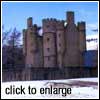|
A Brief History
Pre-history
It is impossible to appreciate Scotland without some
awareness of its history. There are remnants of the past wherever you visit; therefore
lack of background information could lead to frustration. There are several key events
that are easy to remember and form the main stepping-stones in the country's antiquity.
Prior to the Ice Age little evidence of man's existence
in this northern spur of the British Isles exists. Dating from 7,000BC the remains
of brochs, burial chambers and other stone constructions have been uncovered indicating
the presence of early nomadic tribes, probably originating from Asia, passing through
Europe and eventually coming into Britain and Ireland. They settled in a climate
that was several degrees warmer than we know today or continued to travel living
in caves or temporary dwellings and hunting the plentiful reindeer, elk and wild
boar.
 The Neolithic period 4400-2000BC saw settlement along the
Scottish west-coast with early travellers using the Atlantic as their main route
of transport. Villages such as the remarkably well-preserved Skara Brae in Orkney
were probably common throughout the west coast where small groups lived off the land
and nearby sea. The Neolithic period 4400-2000BC saw settlement along the
Scottish west-coast with early travellers using the Atlantic as their main route
of transport. Villages such as the remarkably well-preserved Skara Brae in Orkney
were probably common throughout the west coast where small groups lived off the land
and nearby sea.
The Bronze Age 'Beaker People', so called because
of the clay beakers found in their single graves, were responsible for the many 'henges'
or groups of upright stones found throughout Scotland. These were often formed into
a circle such as the Stones of Callanish of the Western Isles or the Ring of Brodgar
on Orkney. Most of these date from around 2,000 BC.
Between 1000BC and 500BC, Celtic tribes arrived from
France via Ireland. They also settled the western coasts of Britain establishing
new standards in the design of their dwellings and fortifications while their culture
and society flourished. With them came the Iron Age and the advent of new weapons
such as swords and shields, which subsequently lead to a need for better defensive
buildings. The Celts, an enlightened race with fair hair and a rich cultural life
as well as talent for metal-working and agriculture, introduced fortified timber
structures which were followed by stone hill-forts some of which are still standing.
Romans, Scotti and Vikings
 At the time of Julius Caesar's first advance into Britain
in 55BC, Celtic tribes or clans had spread throughout Scotland and, as demand for
good agricultural land grew, were becoming increasingly fractious with one another.
Two principal groups appeared above the isthmus between the rivers Forth and Clyde.
The Romans merely called them Picts and North Britons. At the time of Julius Caesar's first advance into Britain
in 55BC, Celtic tribes or clans had spread throughout Scotland and, as demand for
good agricultural land grew, were becoming increasingly fractious with one another.
Two principal groups appeared above the isthmus between the rivers Forth and Clyde.
The Romans merely called them Picts and North Britons.
Roman rule had brought long-term benefits to conquered
nations throughout Europe but the Picts would have nothing to do with it. Major attempts
were made to subjugate them around AD80 by Agricola, the Roman governor, but despite
victories, the Romans retreated south to build first Hadrian's wall between Carlisle
and the Tyne near Newcastle, then later in AD143, the Antonine Wall between the rivers
Forth and Clyde. In due course the Romans withdrew entirely to lend their services
elsewhere in their troubled Empire, leaving the Picts free to swoop south and cause
havoc with lowland dwellers.
In the early fourth century, a Celtic tribe of Scotti
migrated from Ireland and established themselves on the Kintyre peninsula calling
their kingdom Dalriada. They brought with them the precursor to the Gaelic language
still spoken in the north-west today. Close behind them came Christianity. St Ninian,
a Briton, established the first Christian church at Whithorn in Galloway. St Columba,
a Gaelic speaking Scotti, landed in Iona 150 years later and was the main factor
in integrating the different Pictish tribes by bringing them to his religion.
But it was the Vikings who finally brought an end
to the Picts. From AD800 the Pictish people began to lose tenure at the hands of
raiding Norsemen. Eventually, most of the Northern and Western Isles as well as large
sections of Caithness and Sutherland were under Norse rule.
One Country
At the same time, to the south, Kenneth MacAlpine,
a Scotti king, in AD843, united Dalriada and Pictland. forming the kingdom of Alba,
later to be known as Scotia. He gradually extended his rule to cover the majority
of mainland Scotland.
Unification progressed under the rules of Malcolm
II and Malcolm III whose pious wife, Margaret, helped bring Scotland's religious
life in line with the rest of Europe. It was the son of Malcolm III and Queen Margaret,
David I (1124-53) who was responsible for the many monastic abbeys that sprung up
throughout the country, especially along the Borders. His motivations were not only
religious. His monastic communities, largely made up of imported European monks,
helped extend the king's communication system and therefore control throughout the
kingdom. David I's reign saw an increase in Scotland's overall stability and prosperity
as he prudently granted royal charters to towns and encouraged foreign trade.
Alexander III was known as the last of the Celtic
kings and continued to establish Scotland's affluence. At the Battle of Largs, he
finally expelled the Norse from the Hebridean islands although the subsequent Lords
of the Isles were no real benefit to the national cause, preferring to remain autonomous.
Alexander went on to forge stronger trading bonds with his old enemies, Norway and
England. His untimely death in 1286 heralded the end of this period of growth and,
with no clear heir to the throne, began an era of bitter conflict, mainly issuing
from the south.
Conflict with England
Edward I, having already crushed Wales and determined
to subjugate his northerly neighbour, commenced a protracted campaign that earned
him the title of 'Hammer of the Scots'. He forced Scottish lairds and nobles to sign
a 'Ragman's Roll' acknowledging him to be their king and showed little mercy on those
that stood against him, exterminating, for instance, most of the population of Berwick-upon-Tweed,
then Scotland's main seaport.
 It was inevitable that a hero would rise and lead the nation
against such tyranny and oppression. William Wallace was a relatively unknown knight
who became the leader of the Scottish resistance movement and, in 1297, captured
the fragmented country's imagination when he defeated the far superior English army
at the Battle of Stirling Bridge. His determination inspired young Robert the Bruce,
Earl of Carrick, who was actually married to Edward I's god-daughter to take up the
cause for Scotland's independence. The pair resorted to guerrilla tactics against
the might of Edward's army but Wallace was betrayed and horribly executed in 1305.
In March of 1306, Robert the Bruce was crowned king of Scotland at Scone and almost
immediately become a hunted exile. It was inevitable that a hero would rise and lead the nation
against such tyranny and oppression. William Wallace was a relatively unknown knight
who became the leader of the Scottish resistance movement and, in 1297, captured
the fragmented country's imagination when he defeated the far superior English army
at the Battle of Stirling Bridge. His determination inspired young Robert the Bruce,
Earl of Carrick, who was actually married to Edward I's god-daughter to take up the
cause for Scotland's independence. The pair resorted to guerrilla tactics against
the might of Edward's army but Wallace was betrayed and horribly executed in 1305.
In March of 1306, Robert the Bruce was crowned king of Scotland at Scone and almost
immediately become a hunted exile.
Edward I died in 1307 and left his son, the less militarily
enthusiastic Edward II, to carry on the domination of the Scots but Bruce triumphantly
defeated Edward II's army at Bannockburn in 1314 completing his rout of the occupying
army. The Scottish Wars of Independence reached an unsteady conclusion in 1320 when
eight Scottish earls and thirty-eight barons signed the Declaration of Arbroath,
basically a plea sent to the Pope for freedom from English harassment. Although this
was a milestone in their efforts, the conflict between the two neighbours continued
almost unabated.
The Stewart line of monarchs emerged with Robert II
but control over the country was indeterminate leaving a regent, the Duke of Albany,
to weald effective power. James II, through ruthless means, gained back control for
the crown from the powerful families that had arisen such as the notorious 'Black
Douglases'. The internal power struggle continued through the reigns of James III
and then James IV who, on trying to lend support to his French allies against the
English, was killed at the Battle of Flodden.
James V's daughter, Mary Queen of Scots, on the death
of her father, came to the throne when she was but one week old. She instantly attracted
the attention of the English King, Henry VIII, who wished her to marry his 5-year-old
son, Edward, and bring Scotland under his authority. His aggressive, pre-marital
campaign was later dubbed by Sir Walter Scott as the 'Rough Wooing' when much of
southern Scotland was destroyed in Henry's attempt to seal the love-match.
Instead, Mary was spirited off to France to marry
the dauphin, Francis. Mary, versed in the ways of a Catholic France, returned to
Scotland some 13 years later on the demise of her sickly spouse and was faced with
a country on the brink of religious transformation.
Religious dissent
Known as the Reformation and based on Lutheran principles
and already supported from a converted England, advocates of the new religion such
as George Wishart and John Knox attempted to oust the corpulent, hierarchical Catholic
Church and replace it with Protestantism. With the Confession of Faith in 1560 the
Pope authority was denied and mass outlawed.
The returning catholic Mary Queen of Scots tried to
navigate a middle route between the two opposing religions as well as the powerful,
land-owning barons whom she relied on for support. But this did little to help her
turbulent period of rule and her suspicious cousin, Elizabeth I of England, finally
betrayed her. After 20 years imprisonment she was beheaded.
It was her son, James VI of Scotland who brought the
two nations of England and Scotland together. In a glimmer of confederacy, the Union
of the Crowns in 1603 made him James VI of Scotland and James I of England. Following
his coronation he quickly settled his court in London and came back to his native
land only once during his reign, leaving Scotland much neglected.
The religious issue remained confused through James
VI reign and into his son's Charles I who advocated a form of Catholicism, Episcopacy.
The results, when he tried to administer this to his Scottish subjects, lead to one
of the most perplexing and ferocious eras of Scotland's history.
The signing of the National Covenant in 1685 was an
attempt to thwart Charles' 'Popery' and it raised Charles to war. However the attempt
backfired on the monarch so badly that he ended up declaring war on his own Parliament
for their reluctance to back his battle plans.
The ambivalence of this period came out when Scots,
who largely rejected King Charles' reforms, decided to support him. This lead to
the Marquis of Montrose raising an army against the Covenanters. This was of small
interest compared to the Civil War that had erupted south of the border with the
Covenanters and the Parliamentarians waging war against the crown.
Finally, divisions between factions caused Cromwell
to invade Scotland forcing Charles II into temporary exile. His return in 1660 brought
the 'Killing Times' where many Covenanters were put to death for practising their
beliefs. Scotland's religious wars finally ended with the reign of Mary and William
of Orange and the restoration of the Presbyterian Church.
Political unification
The Union of Parliaments, as opposed to the Union
of Crowns, came about in a period when Scotland faced bankruptcy and further war.
Mounting pressure was being brought to bear on merchants trading across the border
and concern abounded that a catholic Stewart king should regain the Scottish crown.
To avoid this, the Scottish Parliament voted itself out of existence and elected
forty-five Members of Parliament and sixteen peers to sit in the Houses of Parliament
in London. The Union failed to bring Scotland any tangible benefits and support for
the Old Pretender, James Stewart, exiled in France, grew in both Scotland and England.
 The first Jacobite uprising took place in 1715 with the Earl
of Mar raising the Stewart standard at Braemar Castle and taking Perth shortly thereafter.
Mar did not pursue his military advantage and, with the arrival of reinforcements,
the government troops quelled the rebellion. Charles Edward Stewart, better known
as Bonnie Prince Charlie, returned to his native land from France in 1745 in an attempt
to reinstate his father. With no money and few men to start with, he was in only
a short period, surprisingly successful. The first Jacobite uprising took place in 1715 with the Earl
of Mar raising the Stewart standard at Braemar Castle and taking Perth shortly thereafter.
Mar did not pursue his military advantage and, with the arrival of reinforcements,
the government troops quelled the rebellion. Charles Edward Stewart, better known
as Bonnie Prince Charlie, returned to his native land from France in 1745 in an attempt
to reinstate his father. With no money and few men to start with, he was in only
a short period, surprisingly successful.
The conflict ended at the Battle of Culloden when
Hanovarian troops crushed the Jacobite corps, slaughtering most of the wounded and
hounding to death any that escaped. The aftermath of Culloden was perhaps worse than
the event itself when the Duke of Cumberland's troops humbled the Highland spirit.
They sought out any remaining supporters and, with the Proscription Acts of 1746,
banned the wearing or tartan, bearing of arms and the playing of bagpipes.
Culloden heralded a major change in Highland life.
The lairds and landlords, once dependent on their tenantry for military support found
they were no longer able to raise arms. At the same time they realised there was
more profit to be had in sheep and sporting estates. The relatively large populations
resident in the glens and on the islands of Scotland's west coast were forced off
their crofts and given little option other than to emigrate, mostly to Canada and
America, which they did in great numbers. It was not until the Crofter's Act of 1886
that Highlanders enjoyed any form of security of tenure. Emigration continued from
Scotland up until and throughout the twentieth century.
|




